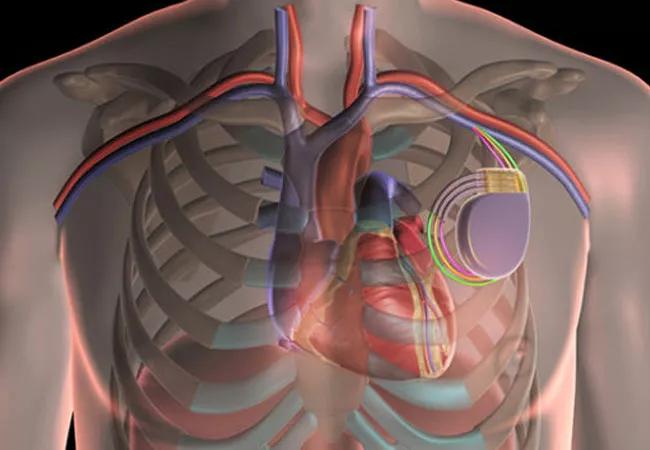Results achieved despite increased complexity and venous occlusive disease

Rates of procedural success and complications were no different between de novo cardiac resynchronization therapy (CRT) implants and upgrades. That is the major finding of a Cleveland Clinic study published in JACC: Clinical Electrophysiology. As the largest single-center study of this issue to date, its results can help guide treatment decisions.
Advertisement
Cleveland Clinic is a non-profit academic medical center. Advertising on our site helps support our mission. We do not endorse non-Cleveland Clinic products or services. Policy
“There have been many different practices in the U.S. and globally regarding initial CRT implants and upgrades,” says the study’s senior author, Daniel Cantillon, MD, Associate Section Head of Electrophysiology and Pacing at Cleveland Clinic. “This study may not totally resolve the issue, but it provides a compelling piece of evidence to support medical decision-making.”
There has been longstanding controversy in the electrophysiology and heart failure communities regarding initial CRT implant and upgrade strategies. “What do you do with a patient with congestive heart failure and a solid indication for a pacemaker with one or two leads (wires) but who is a borderline candidate for a third lead to the left lower chamber?” Dr. Cantillon says. “This whole project stemmed from a robust debate over CRT de novo implants versus upgrade among expert panelists during a medical conference.”
Implanting a third left ventricular (LV) lead presents technical challenges, requiring more time and skill; it also exposes the patient to a longer, more complicated procedure. If the patient doesn’t need a third lead initially but does at a later time, there may be complications due to the presence of preexisting transvenous leads, a pulse generator with pocket fibrosis and venous occlusive disease.
Data on CRT upgrade outcomes are limited, and prior comparative studies have had conflicting results. A large study of the U.S. National Inpatient Sample (NIS) revealed a higher incidence of complications during CRT upgrade relative to de novo implant, while two large European studies of CRT procedures (here and here) found no difference in complication rates.
Advertisement
In addition to evaluating outcomes, the Cleveland Clinic study looked at the technical challenges encountered during CRT upgrades, including their relationship to implant success rates, complications and strategies used to overcome them.
The study examined 1,496 patients who underwent a transvenous CRT procedure at Cleveland Clinic between 2013 and 2018: 947 (63%) were de novo implants and 549 (37%) were upgrades. Upgraded patients were older (70 ± 12 vs. 68 ± 13 years) and more predominantly male (75% vs. 66%) with a higher prevalence of comorbidities.
All participants were reviewed for procedure outcome, 90-day complications, reasons for unsuccessful LV lead delivery and the presence of venous occlusive disease requiring advanced implant techniques.
No significant difference was found between de novo CRT implants and upgrades in procedural success rates (97% vs. 96%, respectively) or 90-day complications (5.1% vs. 4.6%, respectively). Venous occlusive disease was present in 23% of upgrades and more common in patients with a dual- vs. single-chamber device (26% vs. 9%) and frequently increased procedural complexity. Use of alternative management strategies — e.g., advanced wire or sheath techniques, vein dilation, lead extraction or medial venipuncture — resulted in similar outcomes.
Dr. Cantillon notes that, by comparison, the REPLACE registry reported an 18.7% major complication rate for upgrades compared with 11% for new implants. “Our complication rates are lower than most contemporary studies,” he says. “Our reviewers were careful to avoid underreporting complications in either group. We wanted to avoid bias and ensure a complete capture of all adverse events.”
Advertisement
“This study refutes the long-held belief by many that CRT upgrade procedures carry more risk and are less successful than de novo implants,” says study co-author John Rickard, MD, a Cleveland Clinic electrophysiologist with a specialty interest in CRT. “Based on these data, patients with cardiac devices who go on to meet CRT criteria should be promptly referred to an electrophysiologist for consideration for device upgrade.”
The findings also are helping Cleveland Clinic providers “more comfortably defer patients with borderline criteria for CRT who need a single- or dual-chamber pacemaker or ICD right now, with the knowledge that there is no ‘penalty’ for needing to upgrade them down the road,” adds study co-author Oussama Wazni, MD, Section Head of Electrophysiology and Pacing.
As a high-volume center, Cleveland Clinic has the expertise and resources to successfully manage upgrade-related complexities, such as venous occlusive disease. “Community hospitals can use these data to help decide whether to invest in developing the skills and resources to perform upgrades or whether it makes more sense to refer patients to the nearest tertiary center,” Dr. Cantillon notes.
The CRT landscape is evolving rapidly, with newer techniques to achieve CRT using only two leads involving His bundle pacing and left bundle pacing. “We have to take a refreshed view of how these techniques and technologies impact clinical decision-making and do even better for our patients,” Dr. Cantillon concludes.
Advertisement
Advertisement

Series of 145 patients characterizes scope of presentations, interventions and outcomes

Microvascular “supercharging” is a critical newer step to promote favorable outcomes

Why Cleveland Clinic is launching its cardioimmunology center

End-of-treatment VALOR-HCM analyses reassure on use in women, suggest disease-modifying potential

New Cleveland Clinic data challenge traditional size thresholds for surgical intervention

3 specialists share multidisciplinary perspectives on a widely impactful cardiovascular condition

Experience-based takes on valve-sparing root replacement from two expert surgeons

Two surgeons share insights on weighing considerations across the lifespan